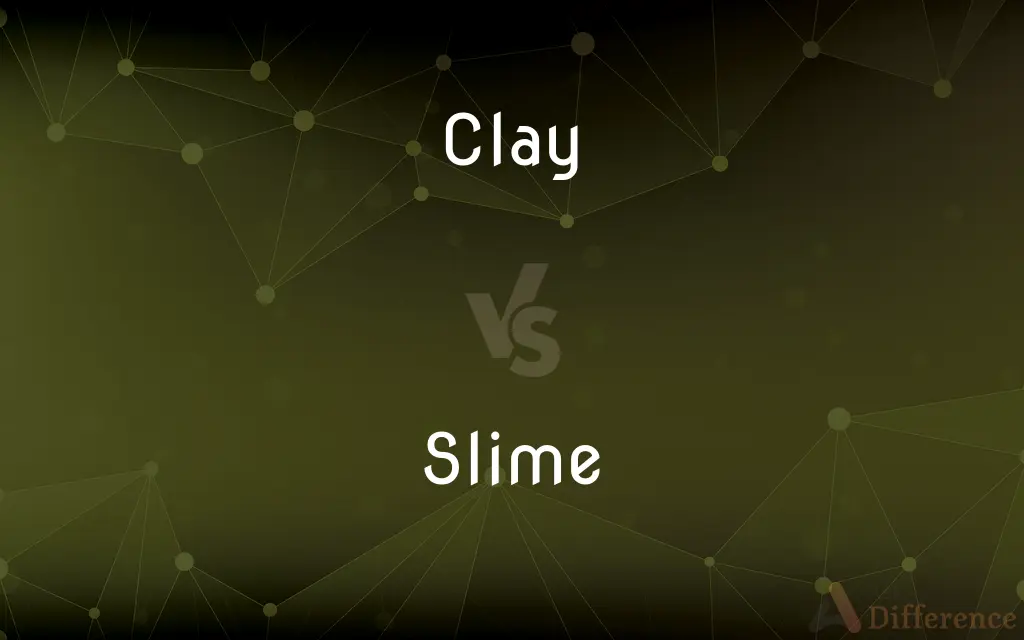Clay vs. Slime — What's the Difference?
By Tayyaba Rehman & Fiza Rafique — Updated on March 1, 2024
Clay is a natural, earthy material known for its plasticity when wet, widely used in ceramics and construction, while slime is a viscous, slippery substance, often synthetic, used for play and educational purposes.

Difference Between Clay and Slime
Table of Contents
ADVERTISEMENT
Key Differences
Clay, sourced from the earth, has been a cornerstone in construction and art for millennia, valued for its moldability when moist and strength when fired. Slime, in contrast, is a modern, playful substance, engineered for its unique tactile properties, engaging senses and creativity without the durability or permanence of clay.
Clay requires water to become pliable and can be permanently shaped through firing, slime remains constantly malleable, returning to its original form, offering temporary manipulation without long-term transformation. This fundamental difference highlights clay's role in creating lasting artifacts versus slime's purpose for temporary enjoyment and learning.
Clay's use spans practical applications such as pottery and bricks, reflecting its historical and cultural significance. Slime, however, thrives in educational and recreational contexts, where its sensory appeal and non-toxicity make it safe and fun for children.
The environmental impact of both materials also diverges; clay, as a natural material, has a minimal footprint when sourced responsibly, whereas the synthetic components of slime raise concerns regarding biodegradability and plastic pollution.
Despite these differences, both clay and slime offer therapeutic benefits; clay's tactile nature supports fine motor skill development and artistic expression, while slime provides sensory play, aiding in stress relief and concentration.
ADVERTISEMENT
Comparison Chart
Composition
Natural earth materials, minerals.
Synthetic polymers, coloring, and additives.
Texture
Plastic when wet, hard when fired.
Consistently viscous and stretchy.
Primary Use
Ceramics, construction, art.
Play, education, stress relief.
Durability
Permanent when fired, weather-resistant.
Temporary, degrades over time.
Environmental Impact
Low with responsible sourcing, natural.
Concerns over biodegradability, synthetic waste.
Compare with Definitions
Clay
Can be air-dried or fired in a kiln for permanence.
After shaping, the clay was fired at a high temperature to create durable ceramic ware.
Slime
A gooey, viscous substance often made from a mixture of water, glue, and borax.
The child laughed as the slime oozed through his fingers.
Clay
Contains minerals like kaolinite, montmorillonite, or illite.
The clay's high kaolinite content makes it perfect for fine porcelain.
Slime
Raises environmental concerns due to its synthetic materials.
Eco-friendly alternatives to traditional slime are becoming more popular.
Clay
A natural, earthy material that is pliable when wet and hardens when heated.
She molded the clay into a beautiful vase.
Slime
Can be homemade or purchased, with various colors and textures.
They made pink glitter slime at the birthday party.
Clay
Clay is a type of fine-grained natural soil material containing clay minerals. Clays develop plasticity when wet, due to a molecular film of water surrounding the clay particles, but become hard, brittle and non–plastic upon drying or firing.
Slime
Popular as a sensory play tool and stress reliever.
Playing with slime helps her focus during homework.
Clay
Has therapeutic properties in art therapy and education.
Working with clay can significantly improve children's motor skills.
Slime
Not suitable for creating lasting objects; primarily for entertainment.
The slime eventually dried out, but it was fun while it lasted.
Clay
A stiff, sticky fine-grained earth that can be moulded when wet, and is dried and baked to make bricks, pottery, and ceramics
A clay soil
A clay tile
The soil is mainly clay
The rocks are covered by various mixtures of loose clays and sands
Slime
A thick, sticky, slippery substance.
Clay
Used for making bricks, pottery, and sculptures due to its malleability.
Ancient civilizations built homes with clay bricks.
Slime
Soft moist earth; mud.
Clay
A clay pipe for smoking tobacco.
Slime
Any mucilaginous substance; any substance of a dirty nature, that is moist, soft, and adhesive.
Clay
A clay pigeon.
We went shooting clays at the weekend.
Slime
To smear with slime.
Clay
A soft earth, which is plastic, or may be molded with the hands, consisting of hydrous silicate of aluminium. It is the result of the wearing down and decomposition, in part, of rocks containing aluminous minerals, as granite. Lime, magnesia, oxide of iron, and other ingredients, are often present as impurities.
Slime
Any thick messy substance
Slime
Cover or stain with slime;
The snake slimed his victim
Common Curiosities
What is clay made of?
Clay is composed of natural earth materials and minerals like kaolinite.
Do both clay and slime have educational benefits?
Yes, both can aid in learning through sensory play and creative expression.
Are there eco-friendly slimes?
Yes, there are biodegradable slimes made with natural ingredients.
Can slime be made at home?
Yes, slime can easily be made with household ingredients like glue, water, and borax.
What makes slime popular among kids?
Its tactile, sensory appeal and the fun of making it are key reasons for its popularity.
Is clay environmentally friendly?
Generally, yes, especially if sourced responsibly and used in its natural form.
Is slime safe for all ages?
While non-toxic slimes are safe, it's important to supervise young children to avoid ingestion.
Can clay be colored like slime?
Yes, clay can be colored with glazes or pigments, especially before firing.
Can you fire slime in a kiln?
No, slime cannot be fired; it would burn or degrade due to its synthetic materials.
How long does slime last?
Slime's lifespan varies but typically degrades after a few months, depending on its components.
Can clay be reused?
Unfired clay can be rehydrated and reused, but once fired, it is permanent.
Why is clay important in history?
Clay has been crucial for making durable goods like pottery, bricks, and sculptures throughout history.
Can both materials be used in professional art?
While clay is a staple in professional art, slime is less common but can be used in modern, experimental art forms.
What's the primary difference between clay and slime?
Clay is a natural, moldable material that hardens when fired, while slime is a synthetic, always malleable substance.
Is slime easy to clean?
Slime is generally easy to clean from non-porous surfaces but can stick to fabrics and hair.
Share Your Discovery

Previous Comparison
Couching vs. Coaching
Next Comparison
Malaria vs. DengueAuthor Spotlight
Written by
Tayyaba RehmanTayyaba Rehman is a distinguished writer, currently serving as a primary contributor to askdifference.com. As a researcher in semantics and etymology, Tayyaba's passion for the complexity of languages and their distinctions has found a perfect home on the platform. Tayyaba delves into the intricacies of language, distinguishing between commonly confused words and phrases, thereby providing clarity for readers worldwide.
Co-written by
Fiza RafiqueFiza Rafique is a skilled content writer at AskDifference.com, where she meticulously refines and enhances written pieces. Drawing from her vast editorial expertise, Fiza ensures clarity, accuracy, and precision in every article. Passionate about language, she continually seeks to elevate the quality of content for readers worldwide.














































